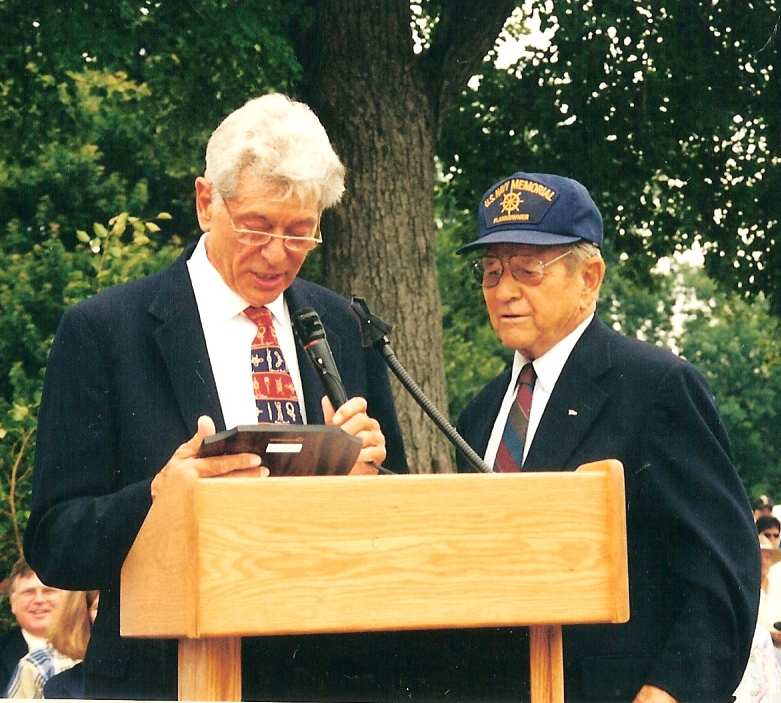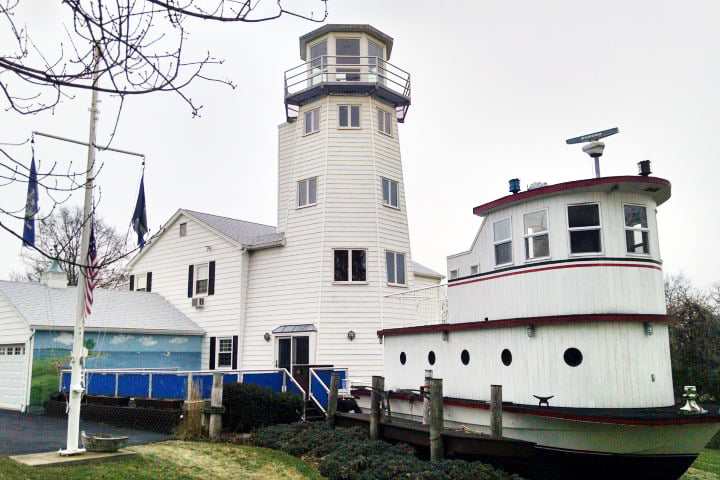By Dan Shine
Voice Columnist
The Lone Sailor
John Masefield
I must go down to the seas again, for the call of the running tide
Is a wild call and a clear call that may not be denied;
And all I ask is a windy day, with the white clouds flying,
And the flung spray and the blown spume, and the seagulls crying.

What do an old block of ice, a statue by the sea, and a home with a lighthouse and tugboat—on a hilltop far from any shore—have to do with one another? Well, it’s like this…
Italian immigrant John DeGrand arrived in America as a five-year old named Generoso DiGrazio in about 1900; he became a naturalized citizen in 1941. He married Josephine Martino in October, 1926 and they had three children. DeGrand was driven to make his fortune in the Land of Opportunity, but he couldn’t read or write, and he barely spoke any English. And furthermore, when it was necessary he signed his name with an “X” or a scribble. But DeGrand’s drive to succeed was a strong one, and by 1928 he had settled in West Haven and started his own business selling ice, coal, oil and vegetables from a horse-drawn wagon. In early photos, we see him as a young man with serious eyes and a determined set to his chin.
One snowy day, John DeGrand was making his rounds with his horse and wagon, when he came across an automobile and driver who were stuck in a snowbank. With the help of his horse, DeGrand freed the automobile from the snow. The driver identified himself as representing the Southern New England Telephone Company, and handed DeGrand his business card; “Stop by my office when you have a chance,” he said. Suddenly, John DeGrand found himself providing moving services for his new friend’s business, storing and shipping telephone company material. And as the years passed, the two businesses would grow and flourish together.

Hill Road, complete with lighthouse-style tower.
John DeGrand’s son Nicholas DeGrand was born in 1933, the third of three children. At his birth, the doctor exclaimed, “Oh, what a big boy!” And so it was that Nicholas’s nickname during his growing years was Big Boy. By this time, the family had settled near the intersection of Forest Road and the Boston Post Road in Allingtown, in a Sears Roebuck house built by the hands of John DeGrand. Out behind the house was a garage that housed their four horses: for John DeGrand, this was the preferred mode of transportation, and he never held a driver’s license.
Nicholas attended Forest School and then West Haven High School. Upon his graduation, he enlisted in the U.S. Navy and changed his name to Martin Nicholas DeGrand, because he liked the name. His time in the service was spent in Groton, Connecticut and Iceland during the Korean Conflict and the Cold War; he served from 1951-1956.
Upon completion of his years of service to the Navy, Marty DeGrand returned to the family business, driving trucks for his father; within a couple of years, he had assumed full control of the family business. In keeping with his father’s tradition, Marty DeGrand was one of those quiet helpers who keep a community moving along. Stories are still told of people whom Marty pulled out of snow and mud, or the time when West Haven Green’s Christmas Tree died and he sent a truck and flatbed trailer to Vermont to bring back a giant Christmas tree–at no cost to the city—but only on condition of anonymity.
By now, the latest DeGrand generation lived near the top of Benham Hill, close to the family business, and close to Benham Hill Firehouse, where Marty served as a volunteer fireman. As his son Tom recalls, the family would be seated around the table at dinner, and Marty would hear the sirens of a fire truck coming up the hill past the house. “He was a fast runner—he’d jump up from the dinner table, sprint out the front door, and jump onto the truck as it went by!” And off to the fire he would go.

Ever the sailor, Marty DeGrand decided that he wanted to place a lighthouse on his property, and nobody could persuade him otherwise. Besides, it was his wife’s wish to be able to see the water from their home, and this was not possible. Marty hired a crane to come to the house and was hoisted up in the air until he could see the water; and that was how he determined the proper height for the structure. Thus, a lighthouse was erected, and along with it a tugboat alongside. Although the lighthouse still stands, the tugboat was recently removed by the current owner.
Another one of Marty DeGrand’s inspirations was also a result of his time in the Navy and his love of the sea: He decided to purchase a statue known as “The Lone Sailor,” and donate it to the city at a site in Old Grove Park. That statue was placed there to much fanfare in 2000.
Marty DeGrand passed away a few years later, but he is warmly remembered by those of whom he knew, and those of the community to whom he gave so freely of his time and talents.
Our thanks to Tom DeGrand and Arlene DeGrand Painter, for their assistance with the preparation of this story.